Earthquakes教案_1
- 格式:docx
- 大小:25.89 KB
- 文档页数:25
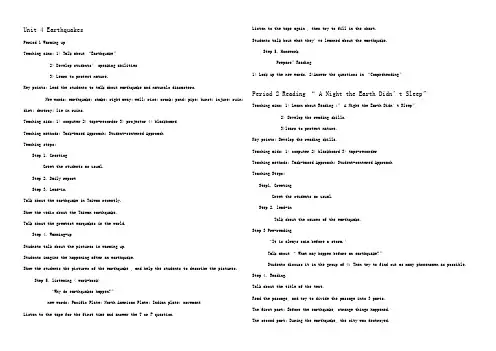
Unit 4 EarthquakesPeriod 1 Warming upTeaching aims: 1) Talk about “Earthquake”2) Develop students’ speaking abilities3) Learn to protect nature.Key points: Lead the students to talk about earthquake and naturalo diasasters.New words: earthquake; shake; right away; well; rise; crack; pond; pipe; burst; injure; ruin; dirt; destroy; lie in ruins.Teaching aids: 1) computer 2) tape-recorder 3) projector 4) blackboardTeaching methods: Task-based Approach; Student-centered ApproachTeaching steps:Step 1. GreetingGreet the students as usual.Step 2. Daily reportStep 3. Lead-in.Talk about the earthquake in Taiwan recently.Show the vedio about the Taiwan earthquake.Talk about the greatest earquakes in the world.Step 4. Warming-upStudnets talk about the pictures in warming up.Students imagine the happening after an earthquake.Show the students the pictures of the earthquake , and help the students to describe the pictures.Step 5. listening ( work-book)“Why do earthquakes happen?”new words: Pacific Plate; North American Plate; Indian plate; movementListen to the tape for the first time and answer the T or F question. Listen to the tape again , then try to fill in the chart.Students talk bout what they’ve learned about the earthquake.Step 5. HomeworkPrepare”Reading1) Look up the new words. 2)Answer the questions in “Comprehending”Period 2 Reading “ A Night the Earth Didn’t Sleep”Teaching aims: 1) Learn about Reading :” A Night the Earth Didn’t Sleep”2) Develop the reading skills.3)learn to protect nature.Key points: Develop the reading skills.Teaching aids: 1) computer 2) blackboard 3) tape-recorderTeaching methods: Task-based Approach; Student-centered ApproachTeaching Steps:Step1. GreetingGreet the students as usual.Step 2. lead-inTalk about the causes of the earthquake.Step 3 Pre-reading“It is always caim before a storm.’Talk about “ What may happen before an earthquake?”Students discuss it in the group of 4; Then try to find out as many phonenomen as possible. Step 4. Reading.Talk about the title of the text.Read the passage, and try to divide the passage into 3 parts.The first part: Before the earthquake, strange things happened.The second part: During the earthquake, the city was destroyed.The third part: After the ear4thquake, people saw hope.Read the text again, and try to anwer the T or F questions in the test-book.Try to filling thr cloze texr according to the text.Step 5 DiscussionTalk about the writing style of the passage .Do the exercised in “Comprehending”.Step 6 Homework.Find out the usage of the key words in the text.Find out the “Attributive Clause” from the text.Teaching Plan for Unit 4Period 3 Grammar ( Attributive Clause)Teaching aims: 1) Talk about the Attributive Clause.2) Students can use the Attributive Clause.Key points: Students learn how to use the Attributive Clause.Teaching aids: 1) computer 2) blackboard 3) text-bookTeaching methods: Task-based Approach; Student-centered ApproachTeaching Steps:Step 1. Greeting.Greet the students as usual.Step 2. Revision.Students read the text aloud one by one.Step 3. Talk about grammar “ Attributive Clause”Talk about the conjunctions of the Attributive clausePeople : who, whom, thatThe boy who/ that is handsome is Tom.( who acts as a subject, cannot be omitted)The boy whom./that/who I saw yesterday is Tom.( wjo, whom, that here act as object, can be omitted) The boy aboyt whom we talked is Tom. ( if there is a preposition, can only use whom, cannot be omitted) things; which , thatPlease pass me the cup which/ that is on the desk.Please pass me the cup which / that you gave me yesterday.Please pass me the cup about which you talked yesterday.whoseI know a boy whose mother is a doctor.I bought a book whose cover is beautiful.Step 4. Practise the Attributive Clause.Class work.Individual work.Step 5. Use the structure.Students use the Attributive Clause to describe one object or a person in the classroom.. Step 6. Homework.Go over the Attributive Clause and do the exercises in workbook.Teaching Plan for Unit 4Period 4. Using LanguageTeaching aims: 1) Studnents practise the languang points of Unit 4.2) Students learn to use the language points.3) develop the abilities of using language.Teaching aids: 1) computer 2) tape-recorder 3) blackboard.Teaching Steps:Step 1. GreetingGreet the students as usual.Step 2. Daily reportStudent gives his report.Step 3 Warming-up.Go over the text in Reading. Students read the text aloud one by one.Step 4 Listening Task.For the first time, students listen to the tape, and answer the T or F questions.For the second listen, students try to answe the questions. ( Teacher can make some pauses to help the students to catch the main information.)Students listen to the third time, then try to follow the tape and practise reading the text aloud. Step 5. Reading TaskStudents read the text and answer the questions.Talk about the letter, and try to find out the structure of the letter.Step 6. Writing Task.Students learn the structure of the letter to the newspaper editor.Students discuss the topic and try to write a letter to the reporter.Step 7. HomeworkModify the letter.。
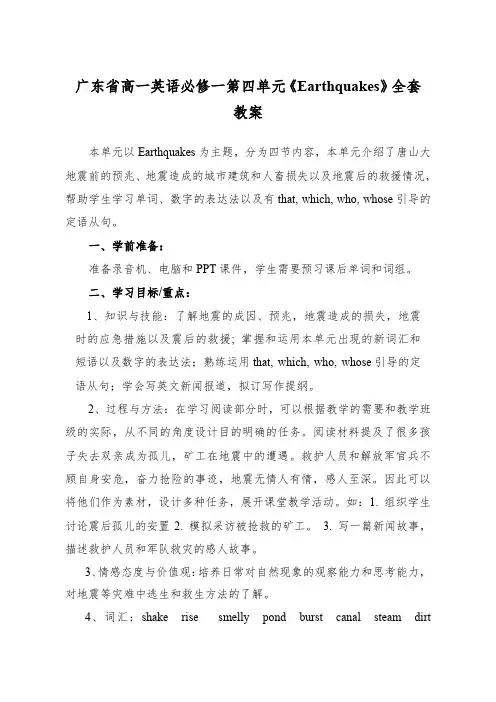
广东省高一英语必修一第四单元《Earthquakes》全套教案本单元以Earthquakes为主题,分为四节内容,本单元介绍了唐山大地震前的预兆、地震造成的城市建筑和人畜损失以及地震后的救援情况,帮助学生学习单词、数字的表达法以及有that, which, who, whose引导的定语从句。
一、学前准备:准备录音机、电脑和PPT课件,学生需要预习课后单词和词组。
二、学习目标/重点:1、知识与技能:了解地震的成因、预兆,地震造成的损失,地震时的应急措施以及震后的救援; 掌握和运用本单元出现的新词汇和短语以及数字的表达法;熟练运用that, which, who, whose引导的定语从句;学会写英文新闻报道,拟订写作提纲。
2、过程与方法:在学习阅读部分时,可以根据教学的需要和教学班级的实际,从不同的角度设计目的明确的任务。
阅读材料提及了很多孩子失去双亲成为孤儿,矿工在地震中的遭遇。
救护人员和解放军官兵不顾自身安危,奋力抢险的事迹,地震无情人有情,感人至深。
因此可以将他们作为素材,设计多种任务,展开课堂教学活动。
如:1. 组织学生讨论震后孤儿的安置2. 模拟采访被抢救的矿工。
3. 写一篇新闻故事,描述救护人员和军队救灾的感人故事。
3、情感态度与价值观:培养日常对自然现象的观察能力和思考能力,对地震等灾难中逃生和救生方法的了解。
4、词汇:shake rise smelly pond burst canal steam dirtruin injure destroy brick dam useless steel shock quake rescue electricity disaster army organize bury coal mine shelter fresh percent speech honor prepare Europe5、短语:at an end right away dig out a (great) number ofgive out thousands of6、重点语法项目:由that, which, who, whose引导的定语从句。
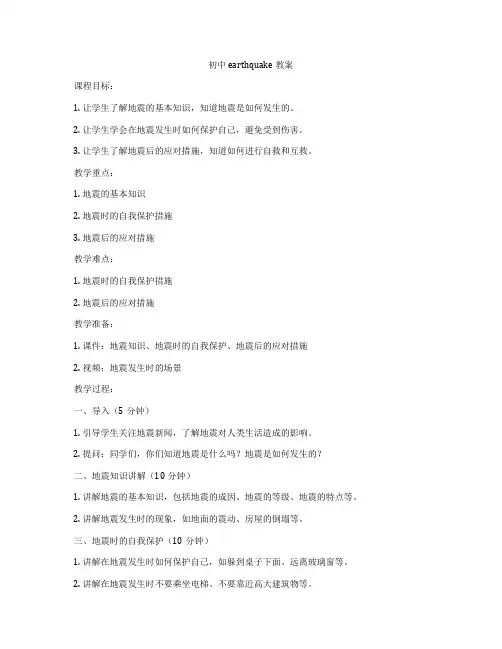
初中earthquake教案课程目标:1. 让学生了解地震的基本知识,知道地震是如何发生的。
2. 让学生学会在地震发生时如何保护自己,避免受到伤害。
3. 让学生了解地震后的应对措施,知道如何进行自救和互救。
教学重点:1. 地震的基本知识2. 地震时的自我保护措施3. 地震后的应对措施教学难点:1. 地震时的自我保护措施2. 地震后的应对措施教学准备:1. 课件:地震知识、地震时的自我保护、地震后的应对措施2. 视频:地震发生时的场景教学过程:一、导入(5分钟)1. 引导学生关注地震新闻,了解地震对人类生活造成的影响。
2. 提问:同学们,你们知道地震是什么吗?地震是如何发生的?二、地震知识讲解(10分钟)1. 讲解地震的基本知识,包括地震的成因、地震的等级、地震的特点等。
2. 讲解地震发生时的现象,如地面的震动、房屋的倒塌等。
三、地震时的自我保护(10分钟)1. 讲解在地震发生时如何保护自己,如躲到桌子下面、远离玻璃窗等。
2. 讲解在地震发生时不要乘坐电梯、不要靠近高大建筑物等。
3. 进行地震逃生演练,让学生熟悉地震逃生的路线和步骤。
四、地震后的应对(10分钟)1. 讲解地震后的应对措施,如寻找安全的地方避难、等待救援等。
2. 讲解在地震后如何进行自救和互救,如止血、救治受伤人员等。
五、总结与反思(5分钟)1. 让学生总结地震时的自我保护措施,加深记忆。
2. 让学生思考如何在地震后进行自救和互救,提高应对能力。
教学评价:1. 学生对地震知识的掌握程度。
2. 学生对地震时的自我保护措施的熟悉程度。
3. 学生对地震后的应对措施的了解程度。
教学反思:本节课通过讲解和演练,让学生了解了地震的基本知识,学会了在地震发生时如何保护自己,知道了地震后的应对措施。
但在教学过程中,发现部分学生对地震知识的掌握程度不高,需要在今后的教学中加强。
同时,地震逃生演练的次数可以适当增加,提高学生的应对能力。
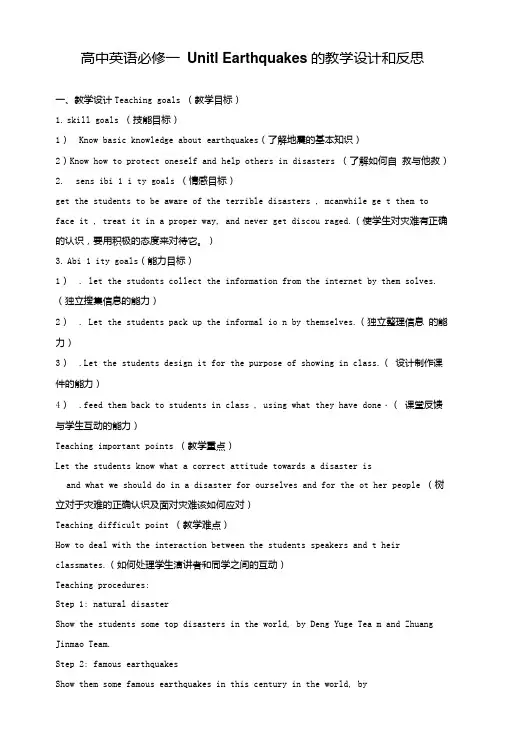
高中英语必修一Unitl Earthquakes的教学设计和反思一、教学设计Teaching goals (教学目标)1.skill goals (技能目标)1)Know basic knowledge about earthquakes(了解地震的基本知识)2)K now how to protect oneself and help others in disasters (了解如何自救与他救)2.sens ibi 1 i ty goals (情感目标)get the students to be aware of the terrible disasters , mcanwhile ge t them to face it , treat it in a proper way, and never get discou raged.(使学生对灾难有正确的认识,要用积极的态度来对待它。
)3.Abi 1 ity goals(能力目标)1). let the studonts collect the information from the internet by them solves.(独立搜集信息的能力)2). Let the students pack up the informal io n by themselves.(独立整理信息的能力)3).Let the students design it for the purpose of showing in class.(设计制作课件的能力)4).feed them back to students in class , using what they have done・(课堂反馈与学生互动的能力)Teaching important points (教学重点)Let the students know what a correct attitude towards a disaster is and what we should do in a disaster for ourselves and for the ot her people (树立对于灾难的正确认识及面对灾难该如何应对)Teaching difficult point (教学难点)How to deal with the interaction between the students speakers and t heir classmates.(如何处理学生演讲者和同学之间的互动)Teaching procedures:Step 1: natural disasterShow the students some top disasters in the world, by Deng Yuge Tea m and Zhuang Jinmao Team.Step 2: famous earthquakesShow them some famous earthquakes in this century in the world, byLin Chuyin Team and Deng Yuge Team.Step 3: Tangshan earthquakea.show them some pictures about Tangshan earthquake by Zhuang JinMaoTeam.b.Watch a video about Tangshan earthquake.Step 4: Signs before earthquakes1.G iven by Wu mengni Team in the form of pictures and words.2.Given by Lin Chuyin Team in the form of filling blanks.Step 5: How to escape from the earthquakea.given by Zeng Jiaxin Team in the form of pictures and words.b.ven by Zhuang Jinmao Team in the form of T or F.c.ven by Lin Gaoxiang Team in the form of T or F.Step 6: Imaginary workSuppose there is an earthquake now, and you can take nothing but one thing, what will you take? Is it money, water, fruits, mobile pho nes, or a torchlight?Step 7: ProverbsGet the students to collect some proverbs from the internet, which a re somethingrelated to how to deal with disasters, what right attitude we should take and so on., then ask them to write them on the blackboard, and explain them to the students one by one.Step 8: Homeworka. pose an earthquake happens in the ; school hall, what should you do?an earthquake happens in the classroom , what should you do? b・pposec.ppose an earthquake happens in the bedroom, what should you do?二、教学反思通过本课教学,我有如下儿点反思:1、创新,以教材为模板,重新设计教学内容。
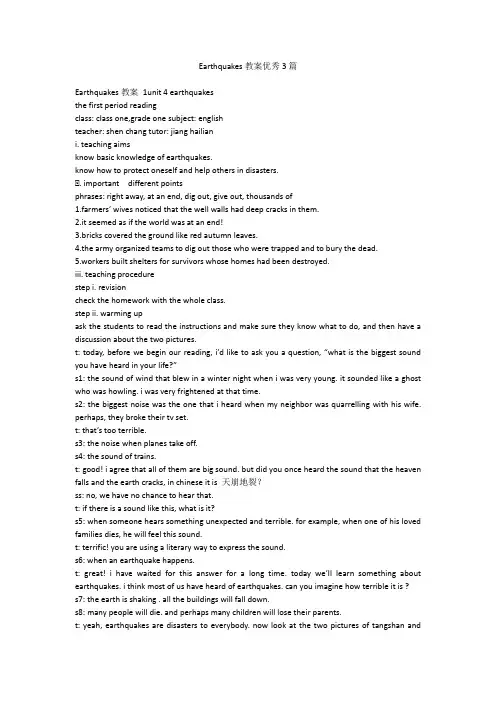
Earthquakes教案优秀3篇Earthquakes教案1unit 4 earthquakesthe first period readingclass: class one,grade one subject: englishteacher: shen chang tutor: jiang hailiani. teaching aimsknow basic knowledge of earthquakes.know how to protect oneself and help others in disasters.ⅱ. important different pointsphrases: right away, at an end, dig out, give out, thousands of1.farmers’ wives noticed that the well walls had deep cracks in them.2.it seemed as if the world was at an end!3.bricks covered the ground like red autumn leaves.4.the army organized teams to dig out those who were trapped and to bury the dead.5.workers built shelters for survivors whose homes had been destroyed.iii. teaching procedurestep i. revisioncheck the homework with the whole class.step ii. warming upask the students to read the instructions and make sure they know what to do, and then have a discussion about the two pictures.t: today, before we begin our reading, i’d like to ask you a question, “what is the biggest sound you have heard in your life?”s1: the sound of wind that blew in a winter night when i was very young. it sounded like a ghost who was howling. i was very frightened at that time.s2: the biggest noise was the one that i heard when my neighbor was quarrelling with his wife. perhaps, they broke their tv set.t: that’s too terrible.s3: the noise when planes take off.s4: the sound of trains.t: good! i agree that all of them are big sound. but did you once heard the sound that the heaven falls and the earth cracks, in chinese it is 天崩地裂?ss: no, we have no chance to hear that.t: if there is a sound like this, what is it?s5: when someone hears something unexpected and terrible. for example, when one of his loved families dies, he will feel this sound.t: terrific! you are using a literary way to express the sound.s6: when an earthquake happens.t: great! i have waited for this answer for a long time. today we’ll learn something about earthquakes. i think most of us have heard of earthquakes. can you imagine how terrible it is ?s7: the earth is shaking . all the buildings will fall down.s8: many people will die. and perhaps many children will lose their parents.t: yeah, earthquakes are disasters to everybody. now look at the two pictures of tangshan andsan francisco. can you describe what you see in the pictures?s1: tangshan is a beautiful city. it has beautiful gardens, broad roads and some tall buildings.s2: from the picture of san francisco, i can see that it is a very big city. there are many tall buildings thickly standing on the earth. i think the population of the city is very large.t: good! what will happen if there has been a big earthquake in these two cities? work in pairs and discuss it. then i’ll ask so me of you to show your opinion.step iii. pre-readingthere are two questions in this part. both are very interesting. the first one can more or less reveal the students’ values; while the second one can enlarge their imagination. no matter what their answers are, as long as they have given careful thoughts to the situations, their answers should be good.t: now, let’s look at the pictures. what are the predictions of an earthquake?s1: before an earthquake animals will become nervous. cows, pigs, horses and dogs will be upset. and people can see mice running about. if the earthquake happens during winter, people can even see snakes.t: terrific! where did you get this knowledge?s1: from geography. i like it.t: good. sit down please.s2: madam, i don’t know the meaning of the picture with two women.t: it doesn’t matter. you will know it soon after reading our text. ok. imagine there is an earthquake now, and your home is shaking, at this moment you have no time to take any other things but one, what will it be?s3: i’ll take all my money. people can’t live without money.s4: i will take as much water as possible. because it is said that people can keep alive for nearly 7 days by drinking without any foods5: in that case, i’d rather take some apples, so that besides drinking, i can also eat.s6: i will carry my grandma. she is my most loved person in this world. she brought me up.t: what a dutiful child you are! i’m very glad to hear that. sit down please! it seems that all of you know what you should do during an earthquake. ok. let’s read our text, and see what it tells us. step iv. readingin this part, teacher should ask the students to read the passage quickly for the first time to get the general idea of the passage. ask them to pay attention to the first sentence of each paragraph. this can help them finish exercise3 in comprehension. it is about the main idea of each paragraph. then ask them to read the text again carefully to obtain some details. before reading for the second time, show some questions on the screen, and let the students read the questions first. these questions can guide them to have a good understanding about the text. they can also make preparations for exs1-2, which are about details.skimmingt: at first i’d like to read the text quickly to get the general idea of the article. while reading, you should pay attention to the sentence of each paragraph.t: have you got the general idea of the text?ss: yes.t: what is it?s1: there is no quick answer to this question. are you suggesting us that the general idea is themixture of the first sentences of each paragraph?t: sure.s1:ok. that’s easy. the main idea of the passage is some signs of the earthquake, and what would happen during the quake.t: good, sit down please. in fact, while we are answering the questions, we have involved the sequence, the functional item for this unit. (teacher writes the word on the blackboard) do you understand the meaning of the word?ss: no.t: sequence means the order of the events. it can tell us which event happens first, and which happens later. do you know the sequence that is used in our text?s3: yes. at first, the text tells us something that happened before the quake, then it tells us the things that happened during the quake and at last it tells us the things that happened after the earthquake.t: quite right! now please look at the screen, these are the first sentences of each paragraph. read them and think if they are the main idea of the text. if necessary, you may make some changes to make more exact.teacher shows the screen and gives a little time to think it over.1.strange things were happening in the countryside in the northeast hebei.2.the disaster happened and caused a lot of loss.3. all hope was not lost.careful readingt: now, it’s time for us to read the text carefully. but before reading, you should read some questions first. these questions may help you get some information quickly and easily. now look at the screen, and read the questions.show on the screen1.what natural signs of a coming disaster were there?2.can you think of some reasons why these signs weren’t noticed?3.what events probably made the disaster worse?4.what situations probably made the disaster worse?5.how were the survivors held?step v. extensionshow the questions on the screen.1.from whose point of view are events described? how do you know?2.what is the mood of this passage? how is it created?3.why do you think the writer chooses to express his feelings about the quake rather than simply reporting what had happened?4.why is the title a night the earth didn’t sleep?5.what does the sentence “slowly, the city began to breathe again.” mean?answers:1.he uses third-person to describe the quake. his description is very objective. for example, the second sentence in the third paragraph. the writer says: “everywhere they looked nearly everything was destroyed.” the writer uses they instead of we.2.the mood is serious and a bit sad. it is created by giving details of how many people and animals were killed or injured, and how many buildings were destroyed.3.although the writer was not there, he felt sad for the people of tangshan. he knows that some personal feelings will make the reading more interesting.4.i think the reason is that, as usual, night is the time to sleep, and night should be safe and quiet. but that night everything changed. the writer uses a night the earth didn’t sleep as a title to show how terrible and how unusual the night was.5.here we can see that the writer compared the city to a person who suffered a lot in the disaster. he felt her pain, and he worried about her. so when he said that people came to help her, we can feel his feelings to the city. the city will not die, she has hope and she can recover from the pain. step vi comprehendinganswers to exx1-31.1. c2. e3.b4.d5.a2.1. the walls of the villages wells had cracks in them.2 .roads got huge cracks3. brick buildings were destroyed.4. the army helped the survivors.5. shelters were put up for those with no homes.3.1. strange things were happening in the countryside in northeast hebei..1.the disaster happened and caused a lot of loss.2.all hope was not lost.step vii homeworkEarthquakes教案2新课标高一必修1英语教案unit 4 earthquakes (简案)teaching plan for unit 4 earthquakesteaching aims and demands:1. topic:basic knowledge of earthquakes; how to protect oneself and help the others in disasters2. useful words and expressions:shake, well (n.), rise, smelly, pond, pipe, burst, canal, steam, dirt, ruin, injure, destroy, brick, dam, useless, steel, shock, quake, rescue, electricity, disaster, army, organize, bury, coal, shelter, fresh, percent, speech, judge, honour, prepare;right away, (be) at an end, dig out, bring in, a (great )number of3. functions:talking about past experiences:i will never forget the day when the earthquake took place. the time was 5:15 in the afternoon and i was driving along the road.sequence4. grammar:the attributive clause (i)由that, which, who, whose引导的定语从句the number of people who were killed or injured reached more than 400,000.it was heard in beijing which is one hundred kilometers away.workers built shelters for survivors whose homes had been destroyed.teaching procedures:period 1.step 1. warming upss discuss and answer some questions:1. which of the following may cause people the greatest damage?a. earthquakeb. typhoonc. floodd. drought2. imagine your home begins to shake and you must leave it right away. you have time to take only one thing. what will you take? why?step 2. pre-readingss discuss and answer:1. do you know what would happen before an earthquake?2. what can we do to keep ourselves safe from an earthquake?3. do you know anything about tangshan earthquake in 1976?step 3. reading1. skimming and find the answers to the following questions:a. what happened?b. when and where did it happen?2. ss read again and fill in the following form:time what happenedbefore the earthquake wells:animals:lights and sound:water pipes:while the earthquake houses, roads and canals:hard hills of rock:the large city:the people:after the earthquake hospitals, factories and buildings:the ground:dams:railway tracks:animals:wells:3. ss read the whole passage again and get the main ideas of each part:part 1. the natural signs of a coming earthquakepart 2. the damage of the city after the earthquakepart 3. the help to the survivorsstep 4. comprehendingss finish ex 1 and 2 on page 27.step 5. assignment1. surf the internet and get more information about the earthquake.2. retell the text.period 2.step 1. warming up1. ss share more information about the earthquake.2. ask some ss to retell the text by using their own words.step 2. language points1. lie –lay-lain (v.) : to be, remain or be kept in a certain state 处于某种状态the village lay in ruins after the war.these machines have lain idle since the factory closed.2. in ruins: severely damaged or destroyed 毁坏an earthquake left the whole town in ruins.his career is in ruins.3. number (n.): a quantity of people or things 数目;数量the number of people applying has increased this year.we were fifteen in number.a number of: a lot ofi have a number of letters to write.a large number of people have applied.4. injure (v.): to hurt oneself/sb./ sth. physically 受伤he fell off the bicycle and injured his arm.5. reach (v.): to achieve or obtain sth. 达成;达到;获得you’ll understand it when you reach my age.at last we reached a decision.6. rescue (n.): an act of rescuing or being rescued 搭救;解救a rescue team is trying to reach the trapped mines.rescue (v.): to save or set free from harm, in danger, or loss 解救;救出the rescued the man from drowning.7. trap(v.): in a place from which one wants to escape but cannot 困住;陷于绝境they were trapped in the burning hotel.8. all …not… = not all…: some but not all 一些;但不是全部not all the girls left.=only some of them left early.not all the children are noisy.=some of the children are not noisy.全部否定应用:none of…none of us were allowed to go there.none of these reports is very helpful.step 3. learning about language1. ss finish ex 1,2 and 3 on page 27 and 28.2. teacher checks the answer and give the ss some help if they have some difficulty.step 4. assignment1. finish wb.ex.1 on page 63.2. ss try to remember the useful words and expressions by hearts.period 3step 1. warming upss read the passage again and try to find the sentences with attributive clauses.e.g. workers built shelters for survivors whose homes had been destroyed.step 2. attributive clause1. give ss more sentences and let the ss to find the structures of the attributive clause.2. ss do some exercises about how to use that, which, who or whose.3. ss finish ex 2 on page 28.some materials about attributive clause:关系代词引导的定语从句关系代词所代替的先行词是人或物的名词或代词,并在句中充当主语、宾语、定语等成分。
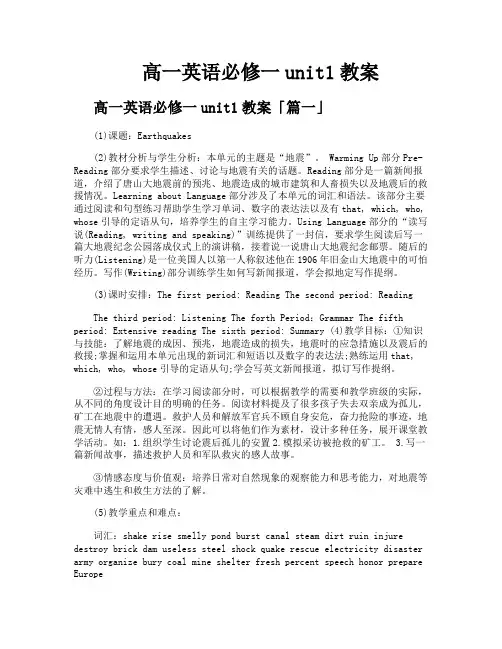
高一英语必修一unit1教案高一英语必修一unit1教案「篇一」(1)课题:Earthquakes(2)教材分析与学生分析:本单元的主题是“地震”。
Warming Up部分Pre-Reading部分要求学生描述、讨论与地震有关的话题。
Reading部分是一篇新闻报道,介绍了唐山大地震前的预兆、地震造成的城市建筑和人畜损失以及地震后的救援情况。
Learning about Language部分涉及了本单元的词汇和语法。
该部分主要通过阅读和句型练习帮助学生学习单词、数字的表达法以及有that, which, who, whose引导的定语从句,培养学生的自主学习能力。
Using Language部分的“读写说(Reading, writing and speaking)”训练提供了一封信,要求学生阅读后写一篇大地震纪念公园落成仪式上的演讲稿,接着说一说唐山大地震纪念邮票。
随后的听力(Listening)是一位美国人以第一人称叙述他在1906年旧金山大地震中的可怕经历。
写作(Writing)部分训练学生如何写新闻报道,学会拟地定写作提纲。
(3)课时安排:The first period: Reading The second period: ReadingThe third period: Listening The forth Period:Grammar The fifth period: Extensive reading The sixth period: Summary (4)教学目标:①知识与技能:了解地震的成因、预兆,地震造成的损失,地震时的应急措施以及震后的救援;掌握和运用本单元出现的新词汇和短语以及数字的表达法;熟练运用that, which, who, whose引导的定语从句;学会写英文新闻报道,拟订写作提纲。
②过程与方法:在学习阅读部分时,可以根据教学的需要和教学班级的实际,从不同的角度设计目的明确的任务。
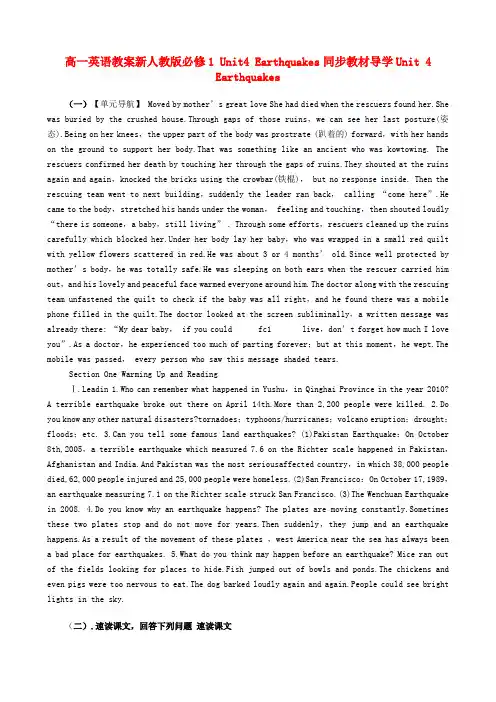
高一英语教案新人教版必修1 Unit4 Earthquakes同步教材导学Unit 4Earthquakes(一)【单元导航】Moved by mother’s great love She had died when the rescuers found her.She was buried by the crushed house.Through gaps of those ruins,we can see her last posture(姿态).Being on her knees,the upper part of the body was prostrate (趴着的) forward,with her hands on the ground to support her body.That was something like an ancient who was kowtowing. The rescuers confirmed her death by touching her through the gaps of ruins.They shouted at the ruins again and again,knocked the bricks using the crowbar(铁棍), but no response inside. Then the rescuing team went to next building,suddenly the leader ran back,calling “come here”.He came to the body,stretched his hands under the woman, feeling and touching,then shouted loudly “there is someone,a baby,still living” . Through some efforts,rescuers cleaned up the ruins carefully which blocked her.Under her body lay her baby,who was wrapped in a small red quilt with yellow flowers scattered in red.He was about 3 or 4 months’ old.Since well protected by mother’s body,he was totally safe.He was sleeping on both ears when the rescuer carried him out,and his lovely and peaceful face warmed everyone around him.The doctor along with the rescuing team unfastened the quilt to check if the baby was all right,and he found there was a mobile phone filled in the quilt.The doctor looked at the screen subliminally,a written message was already there: “My dear baby, if you could fc1 live,don’t forget how much I love you”.As a doctor,he experienced too much of parting forever;but at this moment,he wept.The mobile was passed, every person who saw this message shaded tears.Section One Warming Up and ReadingⅠ.Lead in 1.Who can remember what happened in Yushu,in Qinghai Province in the year 2010?A terrible earthquake broke out there on April 14th.More than 2,200 people were killed. 2.Do you know any other natural disasters?tornadoes;typhoons/hurricanes;volcano eruption;drought;floods;etc. 3.Can you tell some famous land earthquakes? (1)Pakistan Earthquake:On October 8th,2005,a terrible earthquake which measured 7.6 on the Richter scale happened in Pakistan,Afghanistan and India.And Pakistan was the most seriousaffected country,in which 38,000 people died,62,000 people injured and 25,000 people were homeless.(2)San Francisco:On October 17,1989,an earthquake measuring 7.1 on the Richter scale struck San Francisco.(3)The Wenchuan Earthquake in 2008. 4.Do you know why an earthquake happens? The plates are moving constantly.Sometimes these two plates stop and do not move for years.Then suddenly,they jump and an earthquake happens.As a result of the movement of these plates ,west America near the sea has always been a bad place for earthquakes. 5.What do you think may happen before an earthquake? Mice ran out of the fields looking for places to hide.Fish jumped out of bowls and ponds.The chickens and even pigs were too nervous to eat.The dog barked loudly again and again.People could see bright lights in the sky.(二).速读课文,回答下列问题速读课文1.What happened?2.Where did it happen?3.How long did it last?4.Who helped to rescue the trapped people?(三).精读课文,回答下列问题精读课文1.概括每一部分的大意Part 1(Para.1):Before the earthquake,strange things began to happen but no one took any notice of them.Part 2(Paras.2~3):The earthquake destroyed the city of Tangshan and shockedthe people very much.Part 3(Para.4):The army came to help the survivors,bringing hope for a new life.2.True or false?(1)People in Tangshan were warned of the earthquake and didn’t go to bed that night.(F)(2)People in Beijing also felt the earthquake.(T)(3)More than 400,000 people were killed in the earthquake.(F)(4)Many rescue workers and doctors were trapped under the ruins during the aftershock.(T)(5)People tried to get fresh water from under the ground in Tangshan.(F)3.完成下列空格Main idea northeast Hebei. The water in the wells ( 2 )rose and ( 3 )fell. Signs before the earthquake (Para.1) A ( 4 )smelly gas came out of the cracks. The chickens and even the pigs were too ( 5 )nervous to ( 6 )eat. Mice ( 7 )ran out of the fields looking for places to hide. Fish about ( 8 )jumped out of their bowls and ponds. At about ( 9 )3∶00 a.m. on July 28,1976,people saw ( 10 )bright lights in the sky. At ( 11 )3∶42 a.m.,the ( 12 )greatest earthquake of the 20th century began. ( 13 )Steam burst from holes in the ground. Damage caused by earthquake (Paras fc1 .2~3) Hard hills of rock became rivers of ( 14 )dirt. ( 15 )Bricks covered the ground like red autumn leaves. Two ( 16 )dams and most of the bridges fell. The railway tracks were now ( 17 )useless piecesof ( 18 )steel. ( 19 )Sand now filled the wells instead of water. Water,food,and ( 20 )electricity were hard to get.4.填入正确的数据(1)1/3 of the nation felt the earthquake. (2)A huge crack that was 8 kilometres long and 30 metres wide cut across houses, roads and canals. (3)In 15 terrible seconds a large city lay in ruins. (4)2/3 of the people died or were injured during the earthquake. Details (1)Strange things were happening in the countryside of (5)The number of people who were k illed or injured reached more than 400,000. (6)All of the city’s hospitals,75% of its factories and buildings and 90% of its homes were gone.5.与同桌讨论、理解下列长难句并尝试翻译成汉语与同桌讨论1.Mice ran out of the fields looking for places to hide. 句子结构分析:现在分词短语 looking for places to hide 在句中表伴随,作伴随状语。
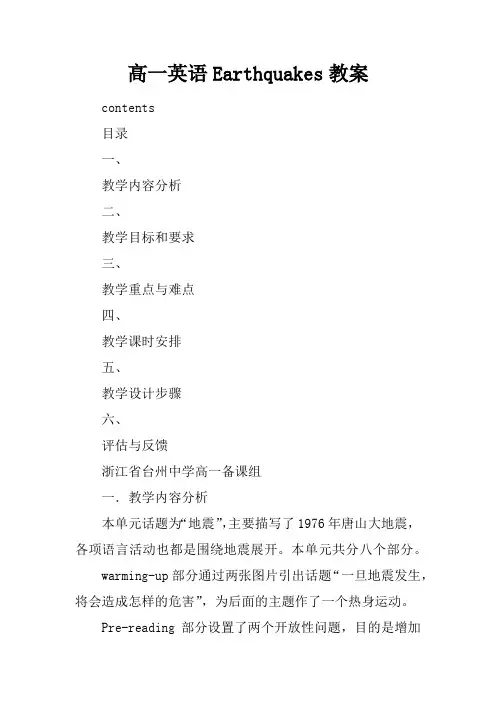
高一英语Earthquakes教案contents目录一、教学内容分析二、教学目标和要求三、教学重点与难点四、教学课时安排五、教学设计步骤六、评估与反馈浙江省台州中学高一备课组一.教学内容分析本单元话题为“地震”,主要描写了1976年唐山大地震,各项语言活动也都是围绕地震展开。
本单元共分八个部分。
warming-up部分通过两张图片引出话题“一旦地震发生,将会造成怎样的危害”,为后面的主题作了一个热身运动。
Pre-reading部分设置了两个开放性问题,目的是增加学生的生活常识,提高他们的应变能力。
这部分为接下来的阅读作了很好的铺垫,学生可通过套乱,参阅有关地震的书籍并运用一些生活常识来回答这两个问题。
Reading部分具体描写了1976年唐山大地震的震前、震中和震后。
作者详细描述了地震来临前的一些不正常的自然现象及动物的反常表现;地震的来势汹汹并在顷刻间将整座城市夷为平地;震后人们勇敢面对现实并及时实施抢救和重建工作。
comprehending部分包括三组练习,主要目的是为了帮助学生更好地理解Reading部分的。
LearningaboutLanguage部分分为两个部分:Discoveringusefulwordsandexpressions和Discoveringusefulstructures.第一部分要求学生在把握的基础上,掌握重点词汇的词义及时用,这更注重培养学生运用上下文猜测词义的能力。
其次还对一些复杂的数字读法进行了检测。
第二部分则结合学习定语从句。
UsingLanguage部分分为Reading,writingandSpeaking;Listening和writing。
Reading,writingandSpeaking包括读一篇邀请函,写一份演讲稿和关于一套新唐山邮票的Littletalk。
Listening部分讲述了一位地震幸存者的故事,并根据听力材料进行正误判断和回答问题,旨在培养学生获取细节的能力,并通过听来模仿标准的语音和语调。
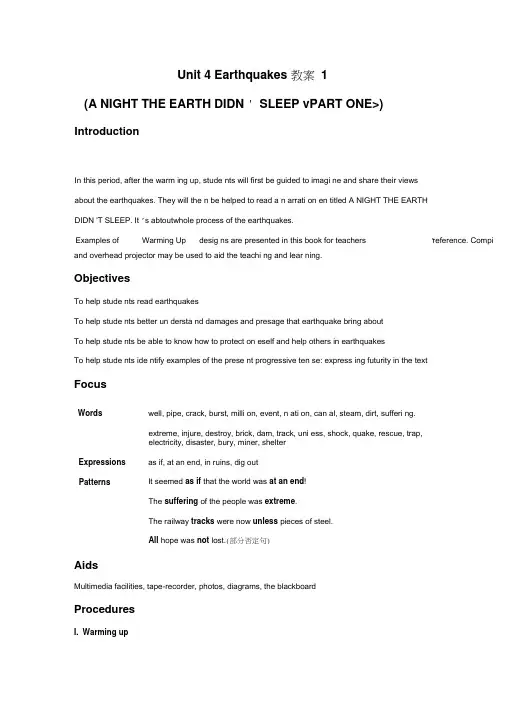
Unit 4 Earthquakes 教案 1(A NIGHT THE EARTH DIDN ' SLEEP vPART ONE>) IntroductionIn this period, after the warm ing up, stude nts will first be guided to imagi ne and share their views about the earthquakes. They will the n be helped to read a n arrati on en titled A NIGHT THE EARTH DIDN 'T SLEEP. It ' s abtoutwhole process of the earthquakes.and overhead projector may be used to aid the teachi ng and lear ning.ObjectivesTo help stude nts read earthquakesTo help stude nts better un dersta nd damages and presage that earthquake bring about To help stude nts be able to know how to protect on eself and help others in earthquakesTo help stude nts ide ntify examples of the prese nt progressive ten se: express ing futurity in the text FocusWords well, pipe, crack, burst, milli on, event, n ati on, can al, steam, dirt, sufferi ng.extreme, injure, destroy, brick, dam, track, uni ess, shock, quake, rescue, trap,electricity, disaster, bury, miner, shelteras if, at an end, in ruins, dig out It seemed as if that the world was at an end !The suffering of the people was extreme .The railway tracks were now unless pieces of steel.All hope was not lost.(部分否定句)AidsMultimedia facilities, tape-recorder, photos, diagrams, the blackboardProceduresI. Warming upExamples ofWarming Up desig ns are presented in this book for teachers 'reference. CompiExpressionsPatterns(1) Warming up by talkingGood morning, class. I think you must know Mr. Nature, and he is emoti on al. Whe n he is happy, we will have a fine weather, so can you describe these views? But he is emoti on al, whe n he gets angry, what will happen? Do you know how many kinds of natural disasters? What are they? Look at the pictures, can you n ame all the disasters?Have you ever experie need an earthquake? Can you describe how terrible an earthquake is?(The earth is shak ing; all the build ings will fall dow n; many people will die; many childre n will become orpha ns.)(2) Warming up by discussingNow, look at the pictures of Tan gsha n and San Fran cisco in warm ing up and describe what you see in the pictures. (beautiful cities; broad roads; tall buildi ng; large populati on.)What will happe n if there has bee n a big earthquake in these two cities?As we all know, earthquakes are disasters to every one. But can we avoid or at least reduce the loss caused by earthquakes? Can we foretell earthquakes? Now let ' come to Pre-reading and decide what may happe n before an earthquake comes.II. Pre-reading by talking and sharing(1) Enjoy a part of film of earthquakeA) What other disasters does it have? (flood/drought/earthquake/fire/typho on /disease and so on)B) Which disaster may cause the worst damage? (earthquake)(2) Ask some questionsA) Have you ever heard a story of an earthquake? (show video of Tan gsha n and San Fran cisco earthquake)B) Have you experie need an earthquake? If you have, tell me your experie nee. If n o, just imagi ne what will happe n before an earthquake?C) The earthquake is comin g, if you 're trapped in the earthquake, how will you feel? What will you do? Will you leave right away? If you have time to take only one thing, what will you take, why?D) What kind of damage can an earthquake cause? (buildings are destroyed; people are killed; families are broken …)III. Reading aloud to the recordingToday, we 'lllear n a text about A NIGHT THE EARTH DIDN 'T SLEEEP. Please liste n and read aloud about the recordi ng of the text A NIGHT THE EARTH DIDN 'T SLEEEP on page 26. Pay attention to the pronunciation of each word and the pauses within each sentence. I will play the tape twice and you shall read aloud twice, too.IV. Reading and answeringFirst, let's look at the title aga in, why the earth did n 'sleep for a ni ght? What happe ned? What does the passage mainly talk about?Excha nge your un dersta nding of the passage with group members and work together to find the main idea of each part.Main idea of each part:Part 1 (para.1): Strange things were happe ning before the earthquake.Part 2 (para.2-3): The disaster happe ned and caused a lot of loss.Part 3 (para.4): All hope was not lost.V. Reading aloud once again and understanding⑴ Read carefully and try to get more information to fill in the blanksPart 1:(2) Individual workPart 2:A) Get the stude nts to find some details of this part.Details:a) At 3:42 am, the greatest earthquake of the 20th century began.b) Steam burst from holes in the ground.c) Hard hills of the rock became rivers of dirLd) Bricks covered the gro und like red autu mn leaves.e) Two dams and most of the bridges fell.f) The railway tracks were now useless pieces of steel.g) Sand now filled the wells in stead of water.h) Water, food, and electricity were hard to get.B) Fill in the bla nks with the dataa) 13 of the n atio n felt the earthquake.b) A huge crack that was 8 kilometers long and 30 meters wide cut across houses.c) In 15 terrible sec onds a large city lay in ruins.d) 2/3 of the people died or were injured duri ng the earthquake.e ) The nu mber of people who were killed or injured reached more tha n 400,000.f) All of the city 'hospitals, 75% of its factories and buildings and 90% of its homes were gone.VI. Reading and summing upSeveral days before July 28, 1976, many stra nge things happe ned in Tan gsha n. They were sig ns for the earthquake. At 3:42 am that day, the earth bega n to shake, which destroyed the city. Later that after noon, ano ther big earthquake struck Tan gsha n. More people were killed or injured and more buildings fell down. Soldiers were called in to help the rescue workers. Teams were orga ni zed to dig out the trapped and bury the dead.VII. Discussing in groups⑴ How were the people helped by the army?A) The army orga ni zed teams to dig out those who were trapped and to bury the dead.B) Mi ners were rescued from the coal min es.C) Shelters were built for survivors whose homes had bee n destroyed.D) Fresh water was take n to the city.Let the groups have a discussi on with their part ners about more ways to help the people in the earthquake.(2) What shall we do or not do if an earthquake happens?DosA) Stay in a small room, such as kitche n or bathroom.B) Hide un der the table or bed, if you have n 'time to escape, you may sta nd close to the in side wall with some things coveri ng on the head.C) If you stay in the ope n air, keep off the tall buildi ng, and go to the fields without trees.Don'sA) Be close to the outside wallB) Stay on the balc onyC) Jump out of the tall buildi ngsD) Use the liftVIII. Closing down by taking a quizTrue or False(1) There were one millio n people in Tan gsha n at that time. T(2) The earthquake bega n 10 kilometers directly below the city. F(3) Not only the people but also the ani mals were shocked greatly. T(4) There was only one quake at that time. F(5) Before the earthquake there wasn 'anything strange happening. F(6) Workers rescued most of the 10,000 coal miners to the south of the city. F(7) Almost everyth ing in Tan gsha n was destroyed. TIX. Homework(1) Surf the internet to find more in formati on about earthquakes.(2) Finish the Comprehe nding part on page 27.。
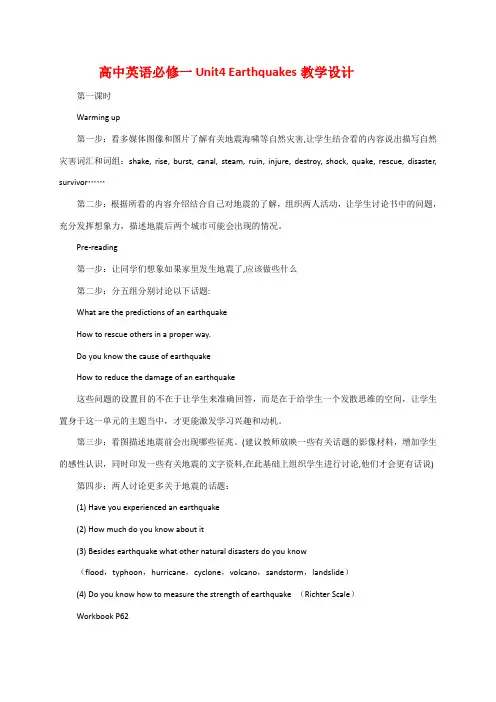
高中英语必修一Unit4 Earthquakes教学设计第一课时Warming up第一步:看多媒体图像和图片了解有关地震海啸等自然灾害,让学生结合看的内容说出描写自然灾害词汇和词组:shake, rise, burst, canal, steam, ruin, injure, destroy, shock, quake, rescue, disaster, survivor……第二步:根据所看的内容介绍结合自己对地震的了解,组织两人活动,让学生讨论书中的问题,充分发挥想象力,描述地震后两个城市可能会出现的情况。
Pre-reading第一步:让同学们想象如果家里发生地震了,应该做些什么第二步:分五组分别讨论以下话题:What are the predictions of an earthquakeHow to rescue others in a proper way.Do you know the cause of earthquakeHow to reduce the damage of an earthquake这些问题的设置目的不在于让学生来准确回答,而是在于给学生一个发散思维的空间,让学生置身于这一单元的主题当中,才更能激发学习兴趣和动机。
第三步:看图描述地震前会出现哪些征兆。
(建议教师放映一些有关话题的影像材料,增加学生的感性认识,同时印发一些有关地震的文字资料,在此基础上组织学生进行讨论,他们才会更有话说)第四步:两人讨论更多关于地震的话题:(1) Have you experienced an earthquake(2) How much do you know about it(3) Besides earthquake what other natural disasters do you know(flood,typhoon,hurricane,cyclone,volcano,sandstorm,landslide)(4) Do you know how to measure the strength of earthquake (Richter Scale)Workbook P62(这部分听力材料的内容刚好是针对以上话题的,关于地震产生的原因和影响)第一步:先让学生猜测练习一中的陈述哪些是正确的,哪些是错误的。
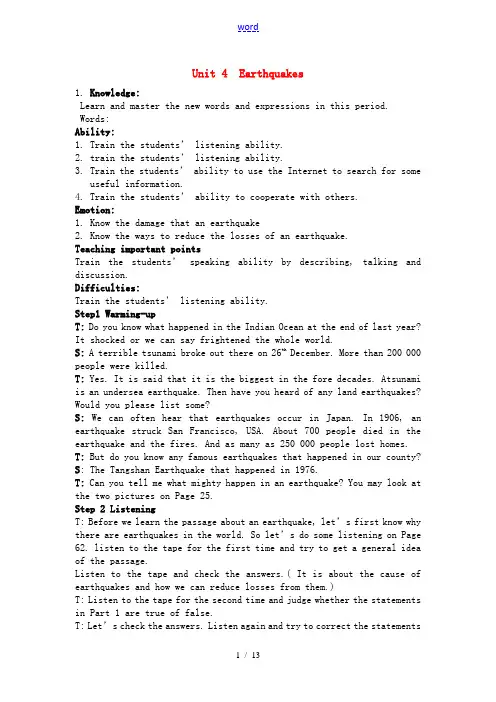
Unit 4 Earthquakes1.Knowledge:Learn and master the new words and expressions in this period.Words:Ability:1.Train the students’ listening ability.2.train the students’ listening ability.3.Train the students’ ability to use the Internet to search for someuseful information.4.Train the students’ ability to cooperate with others.Emotion:1.Know the damage that an earthquake2.Know the ways to reduce the losses of an earthquake.Teaching important pointsTrain the students’speaking ability by describing, talking and discussion.Difficulties:Train the students’ listening ability.Step1 Warming-upT:Do you know what happened in the Indian Ocean at the end of last year? It shocked or we can say frightened the whole world.S: A terrible tsunami broke out there on 26th December. More than 200 000 people were killed.T: Yes. It is said that it is the biggest in the fore decades. Atsunami is an undersea earthquake. Then have you heard of any land earthquakes? Would you please list some?S:We can often hear that earthquakes occur in Japan. In 1906, an earthquake struck San Francisco, USA. About 700 people died in the earthquake and the fires. And as many as 250 000 people lost homes. T: But do you know any famous earthquakes that happened in our county? S: The Tangshan Earthquake that happened in 1976.T: Can you tell me what mighty happen in an earthquake? You may look at the two pictures on Page 25.Step 2 ListeningT: Before we learn the passage about an earthquake, let’s first know why there are earthquakes in the world. So let’s do some listening on Page 62. listen to the tape for the first time and try to get a general idea of the passage.Listen to the tape and check the answers.( It is about the cause of earthquakes and how we can reduce losses from them.)T: Listen to the tape for the second time and judge whether the statements in Part 1 are true of false.T: Let’s check the answers. Listen again and try to correct the statementsthat are false.T: Listen again and try to plete the table in Part 2.A few minutes later, check the answers.Step 3 Homework1.Preview the reading passage on Page 26 and do exercise I in the part“Learning about language”.2.Ask the to look for more ways of reducing losses from earthquakes. Thestudents can go to the library or use the Internet to search for information. After searching for the information, each group should make a poster, informing people how to reduce the losses of an earthquake.Record after teaching :_____________________________________________________________________ _____________________________________________________________________ _____________________________________________________________________ _____________________________________________________________________ _____________________________________________________________________ _____________________________________________________________________ _____________________________________________________________________ _____________________________________________________________________ _____________________________________________________________________The Second PeriodKnowledge:Learn some new, phrases and some new sentence patterns.Ability:1.learn some detailed information about an earthquake.2.improve the students’ reading ability.3.train the students’ability to grasp key information while listening.4.train the students’ speaking ability.Emotion:1.Train the students’ ability to cooperate with others.2.Know the deadliness of an earthquake and the signs before an earthquakeis ing.3.Learn from the bravery of people in Tangshan to face the reality andrebuild the city.Teaching important points:1 The new words and expressions.2. Learn some detailed information about an earthquake.3. Train the students’ ability to cooperate with others.4. Train the students’ speaking ability.Teaching difficulties:1 Words: shake, burst, rise, destroy, shock, fresh, injure2. Phrases: right away, at an end3. Sentence patterns:(1) It seemed/ seems that…(2) The number of sb./sth. Reached/reaches…(3)All hope was not lost.4. Improve the students’ reading ability.5. Train the students’ability to grasp key information while listening Teaching procedures:Step 1 Pre-readingT: Suppose you are warned of a ing earthquake. Now you have time to take only one thing. Tell your partner what you will take and the reason. T: If an earthquake is around the corner, there must be some abnormal phenomena. Carefully look at the four pictures on Page 25 and try to describe what you have seen.Step2 ListeningT: Everyone knows that an earthquake is very terrible. Today, we will learn something about the strongest earthquake in China’s history, which happened in Tangshan, Hebei, in 1976. First listen to the tape with your textbooks closed and check whether the following statements are true or false. If it is false, try to correct it.1.People in Tangshan were warned of the earthquake and didn’t go to bedthat night. (F)2.People in Beijing also felt the earthquake. (T)3.More than 400 000 people were killed in the quake. (F)4.Many rescue workers and doctors were trapped under the ruins duringthe aftershock. (T)5.People tried to get fresh water from under the ground in Tangshan. (F) Step 3 Reading1.Finish Part 1-2 in prehending on Page 27.2.Finish Part 3 in prehending on Page 27.3.Read the passage again to get important information about TangshanEarthquake and fill in the blanks. ( 百思英语 Page 44 )Step 4 Speaking or Reading aloudIf your students are good at English, ask them to do this exercise: Suppose one of you was a newspaper reporter, and the other was a witness of the 1976 Tangshan Earthquake. Now the newspaper reporter is asking the witness some questions. Work in pairs please.If your students are very poor in English, ask them to do this exercise: Play the tape for the students to listen and follow in order to let them know how to read the text.Step 5 Homework1.Read the text several times.2.Do exercise 3 on Page 28.3.Do exercise 2 on Page 28 in the exercise book and hang it in tomorrow.4.Learn some words and phrases in this unit and make some sentences withthem. ( Ss’ Book, Page 82-84)Record after teaching :_____________________________________________________________________ _____________________________________________________________________ _____________________________________________________________________ _____________________________________________________________________ _____________________________________________________________________ _____________________________________________________________________ _____________________________________________________________________ _____________________________________________________________________ _____________________________________________________________________The Third PeriodKnowledge:1.words: crack, burst, ruin, injure, destroy, shock, last2.phrases: at an end, right away, dig out3.sentence patterns:All hope was not lost.Ability:1.Train the students’ ability to read different numbers in English.2.Learn the usage of some difficult words and expressions.3.Train the students’ability to remove the difficulties while reading. Emotion:1.Train the students’ ability to cooperate with others.2.Know the deadliness of an earthquake and the signs before an earthquakeis ing.3.Learn from the bravery of people in Tangshan to face the reality andrebuild the city.Teaching important points:1.Train the students’ ability to read different numbers in English.2.Train the students’ ability to cooperate with others.Teaching difficulties:1.The explanation of some difficult words and expressions.2.Train the students’ability to remove the difficulties while reading. Teaching procedures:Step 1 Revision1.T: In the last period , we learned something about the terrible Tangshan Earthquake in 1976, which is the deadliest earthquake in China’s history. Now I am going to ask you some questions based on the Reading passage.(1)What did people in Tangshan see in the sky before the earthquake?(2)What did people notice in the wells?(3)Did people pay any attention to these abnormal phenomena?(4)When did the earthquake begin?(5)Were there any aftershocks?(6)Did the survivors deny the city and go to live in other places? 2. Check the homework (Ex2 on P28). Ask them to recite it after class. Step 2 Learning about NumbersTurn to Page 28 and look at Part 3. Match each word to the number that has the same meaning. Allow the students several minutes to finish the task. Check the answers.Step 3 Important pointsAsk the students to turn to Page 82. Ask some students to make some sentences with the words or phrases. Deal with some difficulties. You can add more phrases.Step 4 homeworkIn order to master the usage of these words and expressions, please do some related exercises.1.Finish off the two parts in Using Words and Expressions on Page 63.2.Translate the sentences on Page 63 into English. Write the Englishsentences in one of your exercise book and hand it in tomorrow. Record after teaching :_____________________________________________________________________ _____________________________________________________________________ _____________________________________________________________________ _____________________________________________________________________ _____________________________________________________________________ _____________________________________________________________________ _____________________________________________________________________ _____________________________________________________________________ _____________________________________________________________________The Fourth PeriodKnowledge:1.Learn the Attributive Clause.2.Learn the difference between Relative Pronouns for the AttributiveClauses.Ability:1.Learn to choose the correct Relative Pronouns for the AttributiveClauses.2.Train the students’ ability to report what others have said. Emotion;Train the students’ ability to cooperate with each other.Teaching important points:1.Learn the Attributive Clause.2.Train the students’ ability to report what others have said. Teaching difficulties:Learn to choose the correct Relative Pronouns for the Attributive Clauses. Teaching procedures:Step 1 revisionCheck the homework exercises.Step 2 Grammar( The teacher writes the sentence “Workers built shelters for survivors whose homes had been destroyed.”O n the blackboard before class begins.) T: Please look at the sentence on the blackboard, paying special attention to the underlined part. What kind of clause is it?Ss: The Attributive Clause.T: Yes. The Attributive Clause tells us which person or thing (or what kind of person or thing ) the speaker means.e.g. The woman who lives next door is a teacher.A sentence with an attributive clause contains two shorter sentences. In the sentence above, the two short sentences are: “The woman is a teacher.”A nd “ The woman lives next door.” The Attributive Clause is the answer to the question: Which woman is a teacher?Would you try to divide the sample sentence on the blackboard into two short sentences?T: That’s right. Now try to find all the sentences with Attributive Clauses in the reading passage and divide each sentence into two short sentences.T: Next I will say something about the mon relative pronouns. “Who”is used for people. “Which”is used for things. “That”is used for things or people. “Whose”is used instead of his/her/their/somebody’s. “Whom” is quite formal, and in most cases it is all right to use who instead. But when whom has a preposition before it, it cannot be replaced by who.Step 3 Practice1. Now look at Part 2 in Discovering Useful Structures on Page 28. try to plete each sentence using that, which, who, or whose.Let the students do this exercise and check the answers.2.Do more exercises in Ex 3 on Page51 in《导学》Step 4 HomeworkAfter class, read the passage on Page 64. It’s about advice on how to protect your home from an earthquake. plete the sentences below, using who, whom, which, that or whose.Record after teaching;_____________________________________________________________________ _____________________________________________________________________ _____________________________________________________________________ __________________________________________________________________________________________________________________________________________ _____________________________________________________________________ _____________________________________________________________________ _____________________________________________________________________ _____________________________________________________________________ .The Fifth PeriodKnowledge:1.Know how to write a speech.2.Know how to write a newspaper story.Ability:1.Train the students’ speaking ability.2.Train the students’ ability to search for doing something.3.Train the students’ ability to do things step by step.Emotion:1.Honor the great people of Tangshan.2.Learn to cooperate to each other.Teaching Important Points:1.Train the students’ speaking ability.2.Train the students’ ability to search for doing something. Teaching Difficulties:1.Know how to write a speech.2.Know how to write a newspaper story.3.Learn to cooperate to each other.Teaching Procedures:Step1 RevisionT: In the last period, we learned the Attributive Clause and how to choose a proper relative pronoun. Now let’s check your homework exercises. Please open your textbooks and turn to Page 64. Look at Part 1 in Using Structures. I will ask some of you to read the sentences out.(The teacher corrects mistakes if there are any.)Step2 Reading and WritingT: Read the letter on Page 29.In the blank at the beginning of the letter, write the last number of the year it is now. Then in the blank near the end of the letter, use a number to say how many years ago the quake happened.(After several minutes, the teacher checks the answers with the class.) T: Suppose you are the student who was invited to give the speech. What should you include in your speech?(Students give their different answers.)T: Yes, while writing, don’t forget to contain the information. Now I will give you 15 minutes to write the speech. You can follow the pointsin part 3 on this page.(While the students are writing, the teacher gets around the classroom and helps the students to deal with any difficulties that they have.) (After 15 minutes)T: Are there any volunteers to read his or her speech?( If there is nobody, the teacher asks one to read, and give some assessments.)Step 3 SpeakingT: Imagine that after your speech, Zhangsha asks you to give a short talk about the new stamps about Tangshan to honor the city. First, ask and answer the following questions in pairs.(1)What do these stamps show?(2)Do you think these stamps are very important and why?(3)Will you collect these stamps? Why and why not?(After the students ask and answer these questions in pairs.)T: Now try to fill in the lines in the little talk. You can use some of the answers to the questions.T: Next I will ask one of you to read the little talk.Step 4 WritingT: By now you have learned writing a speech and a little talk. Now you are going to write an article for a newspaper about a special event that happed in your hometown. First, let’s learn some skills of writing newspaper stories. Before you write, you should write an outline. This is very useful. Today, we will learn how to write an outline. Please turn to Page 31. Read the instructions in bold and pay attention to some questions I prepared to you.Q1: Why is an outline important?Q2: What should an outline include?Q3: Why is a headline important?Q4: What are the steps to finish a newspaper story?Q5: What is the feature of a newspaper story?Suggested answers:1.Because an outline will prepare you to write a better story.2.A good outline should have a headline, a list of main ideas and a listof important details.3.A headline can tell the readers what the topic is, so it can attractthe readers’ attention since the reader may not have bought the newspaper before they read the headline.4.First, organize the main ideas. Next, put some details into eachparagraph.5.A newspaper story gives the most important news first and the leastimportant news last.T: Now let’sread the example of a newspaper story. Try to find the headline, main idea and details of each paragraph. You may work in groupsof three.(After several minutes, the teacher asks the students the following questions :)Q1: What is the headline of the newspaper story?Q2: What is the main idea?Q3: What is the detailed information?T: Now turn to Page 32 and check your main ideals and detailed information. Step 5 HomeworkT: So now you know how to write a passage step by step. Prepare the outline for a short newspaper story for China Daily. Use the example to help you to organize your outline. You can first have a discussion with your partner and decide which event you will write about. Try to write down the title, main ideas and detailed information. Then put them into a short passage. Record after teaching:_____________________________________________________________________ _____________________________________________________________________ _____________________________________________________________________ _____________________________________________________________________ _____________________________________________________________________ _____________________________________________________________________ _____________________________________________________________________ _____________________________________________________________________ _____________________________________________________________________The Sixth PeriodKnowledge:Learn a passage about the San Francisco EarthquakeAbility:1. Learn to pare two similar passages.2. Train the students’ listening ability.Emotion:1. Learn to cooperate with others.2. Learn from the bravery of the people of San Francisco to face the reality.Teaching Important Points:1.Train the students’ listening ability.2. Learn a passage about the San Francisco EarthquakeTeaching Difficulties:Learn to pare two similar passages.Teaching Procedures:Step1 RevisionT: In the second period of this unit, you learnt some detailed informationabout the Tangshan Eearthquake. Can you use several sentences to summarize the passage?S: Let me have a try. The terrible earthquake struck the city of Tangshan while people were sleeping. More than 400 000 people were killed or injured in the quake. After the quake, people found nearly everything was destroyed. But people in Tangshan didn’t lose heart. They rebuilt the city with the help of soldiers.T: Quite good.Step 2 Reading and paringT: In the first period, we also talked about the earthquakes that happened in San Francisco. Today, we wi ll learn a passage titled “The Story of an Eyewitness”, which is about the San Francisco Earthquake in 1906. It was written by Jake London, who was a famous American writer.T: First read the passage carefully. While reading, please think about the following questions:(1)How did the author feel about the earthquake?(2)How did the author feel about the people of San Francisco? (Ss read the passage, then the teacher asks someone to give their answers and checks the answers)(Answers will vary.)T: Quite good. You can keep your own answers as long as you think they are reasonable and you can find proofs from the passage.Read the first paragraph in this passage .Then go back and read again the first paragraph of the passage on Page 26. pare the ways both writers give you details about the earthquakes. Try to finish the 4 exercises on Page 66. You may discuss in group of three.(Ss read the two passage and finish the exercises.)(Then the teacher checks the answers.)T: Next I will play the tape of this passage for you to listen. Please pay special attention to the intonation.(After listening.)T: Now I will give you several minutes to read the third paragraph with feelings.Step 3 ListeningT: Just now we learned a passage written by an eyewitness about the terrible San Francisco earthquake in 1906. Now we will listen to a story told by a man who was a survivor of the earthquake. Listen to the tape the first time, and try to tell whether the statements in part 1 are true or false.(Teacher plays the tape for the students to listen and finish the task.) (After listening, the teacher checks the answers with the class.)T: Now let’s listen to the tape again and try to answer the questions in Part 2.(After listening, the teacher checks the answers)T: While listening to the tape, you should not only pay attention to the contents, but also the pronunciation and intonation. The sentences in Part 3 show us the sequence. I will play the tape again, you should mark liaison and inplete explosion in these sentences. Then practice reading them aloud.Step 4 HomeworkT: In this class we read and listened to two stories ,both of which are about the 1906 San Francisco earthquake. The stories are true and were written for the Museum of the City of San Francisco. The museum has many such personal accounts and photos at /1906/06.html. If you are interested in them, you can surf in the site I’ve given to you. Record after teaching:_____________________________________________________________________ _____________________________________________________________________ _____________________________________________________________________ _____________________________________________________________________ _____________________________________________________________________ _____________________________________________________________________ _____________________________________________________________________ _____________________________________________________________________ _____________________________________________________________________The Seventh PeriodKnowledge:1.Learn how to make an earthquake plan.2.Learn what to contain in a personal earthquake bag.Ability:1.Train the students’ listening ability.2.Train the students’ speaking ability.3.Learn to find reasons for their choices.4.Learn to sum up what they have learned in the unit.Emotion:Learn to cooperate with others.Teaching Important Points:1. Train the students’ listening ability.2. Train the students’ speaking ability.Teaching Difficulties:Learn to find reasons for their choices.Teaching Procedures:Step 1 GreetingsGreet the whole class as usual.Step 2 ListeningT: These days Earthquakes are always our central topic. We have learnedmany things about it. Up till now, earthquakes are difficult to predict. We can hardly avoid an earthquake. But actually we can do things to reduce the losses of an earthquake. Let’s look at the form on Page 66 and have a discussion about the earthquake plan with your partner.( Ss give their answers)T: What should you do if you are outside?(Ss give their answers)T: What should you do if you are in the living room?(different answers)T: What should you do if you are in the house room?(different answers)T: Next we are going to listen to the tape and write down the three “things” that are mentioned.(After listening, teacher checks the answers with the students.)T: Then let’s listen again. This time you should write down more details about each of the “things”.(After listening, teacher checks the answers with the class. Play the tape again if necessary.)Step 3 SpeakingT: You know every family should have an earthquake bag, in which there are enough things that you can use in case of an earthquake. Here we have a list of possible items for the personal earthquake bag. Choose only eight things, which you think are the most essential, from the list. They must last you five days. Discuss with your partner.(After several minutes.)T: Now join another pair and discuss your choices. Put all the things you agree on into a final list. Discuss the other items explaining your reasons and trying to agree which ones are the most suitable. (After several minutes.)T: Each group should choose one representative. Now be prepared to present your list to the class and give your reasons for each choice.Step 4 Learning TipT: In order to learn a language well, you should do a lot of practice, including listening, speaking, reading and writing. Only when we understand what is said to us can we have a conversation with somebody. So listening to English is very important. After class, you should listen to the English news on CCTV International. You will not only get a lot of information about what is happening around the world, but also improve your listening and learn more English words and expressions. At the same, you will improve your pronunciation and intonation.Step 5 Summing upT: Now let’s sum up what you have learnt in this unit. Work with your partner. First write down what you have learned about earthquakes. Then write down the verbs, nouns, expressions and new grammar items that youhave learned from this unit.Step 6 Homework1.Review Unit 4. .2.Preview Unit 5.Record after teaching:_____________________________________________________________________ _____________________________________________________________________ _____________________________________________________________________ _____________________________________________________________________ _____________________________________________________________________ _____________________________________________________________________ _____________________________________________________________________ _____________________________________________________________________ _____________________________________________________________________The End。
Unit 4 Earthquakes阅读课—、教学内容:Pre-reading; Reading and comprehending二、教学目标:1.能力目标1)能够用思维导图形式罗列出地震发生时的各种现象,并对这些现象进行分类。
2)通过快速阅读能够迅速查找到文章段落中的主要信息,并能对这些主要信息进行复述,进而总结归纳出文章的大意。
3)通过仔细阅读能够运用图示来说明段落中支撑句和主题句之间的关系,并能根据自己所画出的图示來复述文章的主要内容。
4)运用英汉语言Z间的对比了解定语从句在英语和汉语屮不同的表达方式。
2.语言目标1)词汇和短语目标well, pipe, burst, million, event, as if, at an end, nation, canal, stream, dirt, in ruins, suffering, extreme, brick, dam, track, useless, shock, quake, rescue, trap, electricity, dig out, bury, mine, miner, shelter2)重点句子It was felt in Beijing, which is more than two hundred kilometers away・A huge crack that was eight kilometers longs and thirty metres wide cut across houses, roads andcanals・The number of people who were killed or injured reached more than 400,000.Later that after noon, ano ther big quake which was almost as strong as the first one shook Tangshan.The army organized teams to dig out those who were trapped and to bury the dead..Workers built shelters for survivors whose homes had been destroyed.三、教学步骤:步骤一阅读前导入1.教师展示四幅关于地震发生时的图片,教师首先使用课文中涉及到的词汇或者短语来描述这些画面, 并在描述的过程当中对生词要加重语气,这样学生可以通过画面和教师言语之间建立联系,从而可以加深对词汇的掌握,如果学生没有听懂,教师可以重复描述一次。
Earthquakes教案contents目录一、教学内容分析二、教学目标和要求三、教学重点与难点四、教学课时安排五、教学设计步骤六、评估与反馈一.教学内容分析本单元话题为“地震”,主要描写了1976年唐山大地震,各项语言活动也都是围绕地震展开。
本单元共分八个部分。
warming-up部分通过两张图片引出话题“一旦地震发生,将会造成怎样的危害”,为后面的主题作了一个热身运动。
Pre-reading部分设置了两个开放性问题,目的是增加学生的生活常识,提高他们的应变能力。
这部分为接下来的阅读作了很好的铺垫,学生可通过套乱,参阅有关地震的书籍并运用一些生活常识来回答这两个问题。
Reading部分具体描写了1976年唐山大地震的震前、震中和震后。
作者详细描述了地震来临前的一些不正常的自然现象及动物的反常表现;地震的来势汹汹并在顷刻间将整座城市夷为平地;震后人们勇敢面对现实并及时实施抢救和重建工作。
comprehending部分包括三组练习,主要目的是为了帮助学生更好地理解Reading部分的。
LearningaboutLanguage部分分为两个部分:Discoveringusefulwordsandexpressions和Discoveringusefulstructures.第一部分要求学生在把握的基础上,掌握重点词汇的词义及时用,这更注重培养学生运用上下文猜测词义的能力。
其次还对一些复杂的数字读法进行了检测。
第二部分则结合学习定语从句。
UsingLanguage部分分为Reading,writingandSpeaking;Listening和writing。
Reading,writingandSpeaking包括读一篇邀请函,写一份演讲稿和关于一套新唐山邮票的Littletalk。
Listening部分讲述了一位地震幸存者的故事,并根据听力材料进行正误判断和回答问题,旨在培养学生获取细节的能力,并通过听来模仿标准的语音和语调。
writing 部分要求学生报纸写一篇新闻报道,学习如何按照规范的步骤进行写作,如选择适当地标题和组织语言等。
另外这一部分也培养学生写作时注意标题、主旨大意和细节。
Summingup部分帮助学生整理、巩固本单元所学到的知识,包括学到的关于地震的知识,有用的动词、名词、表达方式和新的语法项目。
LearningTip部分就听英语方面给出了一些建议,建议学生多听广播或电视里的英语节目.二.教学目标和要求根据《英语新课程标准》关于总目标的具体描述,结合高一学生实际和教材内容,我们将教学目标分为语言知识、语言技能、学习策略、情感态度、文化意识五个方面。
.知识目标(knowledge)①词汇(Vocabulary):shake,rise,crack,burst,well,smelly,pond,steam,destr oy,ruin,injure,survivor,brick,useless,shock,quake,r escue,electricity,disaster,organize,bury,coal,mine,shelter,fresh,perc ent,honor,prepare.②短语:rightaway,atanend,lieinruins,betrappedundersth,toth enorthofsp,putup,giveout,wakesbup,preparesthforsth. ,thinklittleofsth.③语法:定语从句(TheAttributiveclause).能用英语描述任务的特征、行为等----由who/whom/whose/that引导;能用英语描述事物、事件的性质、内容等----由which/that/whose引导。
2.能力目标(Ability)能运用所学语言知识描述地震前兆、危害及震后援救;根据已知信息推测将要听取的材料的内容;提高阅读技能和用英语进行思维、推理、判断的能力;掌握演讲稿的格式及新闻报道的写作步骤和要点。
3.情感目标Affect学习唐山人民勇敢面对自然灾害,积极进行灾后重建的精神;在教学活动中培养学生的合作精神和互助精神。
三.教学重点和难点重点词汇:injure,survivor,shock,rescue,disaster,fresh,judge,prepare 2语法:TheAttributiveclause3难点:运用所学知识表达自己的想法;较长句子成分的划分及意义的理解;如何能就课文内容完成一些开放性的话题讨论,能把课文的内容得以延伸与拓展;指导学生通过各种渠道如报纸、杂志、图书馆和网络等资源查找有关素材,培养信息社会收集查找资料的能力。
四.课时安排本单元共分为四个部分,具体课时教师可根据自身教学实践进行适当地安排和调整。
Part1:warming-up和listening.通过游戏、介绍和VIDEo等手段对地震知识进行适当了解的基础上,引入对SanFrancisco地震的学习,从而进入听力部分。
Part2:Pre-reading,Reading,comprehendingandLearningaboutLa nguage.读前的两个问题:第一个问题问学生在危机情况下会带什么,有利于很好的激起学生的兴趣和调动课堂气氛,由此则可过渡到第二个问题对地震前兆的了解,从而自然地引入到对唐山大地震的学习。
在对唐山大地震震前、震中和震后的学习中,可结合今年唐山大地震30周年的报道,使学生进一步了解唐山大地震和现今的唐山,形成对比和强烈的震撼,从而更好地了解学习唐山人民勇敢面对自然灾害,积极进行灾后重建的精神。
其次,通过对的学习,了解新闻的特点,为后面的写作做准备。
重点词汇和语法的学习可结合进行,并配以适当的练习。
Part3:writing由提前让学生完成的关于唐山的新闻写作来引入对写作的学习。
通过对学生习作的评析,来引出新闻写作中应注意的事项,并通过适当的练习来进行巩固,再让学生对自身的习作进行修改。
Part4:UsingLanguage,主要学习SPEEcH演讲稿的写作。
通过对演讲稿的了解、注意事项和名人演讲的感受,让学生学会如何恰当地写演讲稿。
五.教学步骤warming-up&ListeningTeachinggoals:.Getageneralideaofearthquakesandsomeothernaturaldisa sters;2.Trainstudents’listeningabilityandtrytoimprovetheirpronunciation;3.knowthedamagethatanearthquakeandotherdisasterscould bringaboutandwaystoreducethelossesofanearthquake.Teachingimportantpoints:Trainthestudents’listeningabilityandimprovepronunciation.Teachingaids:Ataperecorder;theblackboard;cIATeachingprocedures:Step1.Lead-in----videoofdifferentnaturaldisastersT:ourhometownisaplacefullofakindofdisasters.whatisi t?Typhoon,earthquake,hurricanetsunami,flood,tornado,d rought…areallcallednaturaldisasters.Q.whatdamagewilltheybringabout?----everythinginruins/death/losses…Step2.IntroductionofEarthquakesQ:whatdoyouknowaboutearthquake?whatcausesquakesandw heredotheyoftenhappen?Howtopredictanearthquake?Q:Howtoavoidbeinghurt??----throughgamesQ:Haveyouheardofanylandearthquakes?----Twopicturesinwarming-up:TangshanEarthquakeandSa nFranciscoEarthquake.Q:whatdoyouknowaboutthesetwoearthquakes?Step3:Listening.Pre-listening----briefintroductionofSanFranciscoEarthquakeQ:whendidthequakehappen?----1906Q:whatdamagedidbringabout?----About700peoplediedintheearthquakeandthefires.An dasmanyas250,000peoplelosthomes…2.while-Listening----accordingtotheexercisesinthetextbook3.Post-listening----Howcanwereducethedamageofearthquake?whatcanwedo?Step4:Homework----previewthereading“ANighttheEarthdidn’tSleep”andlearnnewwordsofthisunitReadingTeachinggoals:.Targetlanguage目标语言Learnandmasterthenewwordsandexpressionsinthisperiod.2.Abilitygoals能力目标Trainthestudents’readingandspeakingability.Trainthestudents’abilitytousetheInternettosearchforsomeusefulinforma tion.Trainthestudents’abilitytocooperatewithothers.Teachingimportantpoints:Trainthestudents’readingability—skimmingandscanning.Teachingdifficultpoints:Describethedisasters.Teachingaids:cIATeachingprocedures:Step1.Lead-inT:wehaveavisittothemuseumofnaturaldisasters,andyouh avelearnedaboutsomebriefintroductionofmostdisasters.Today,Iwanttoshowyouroundtheearthquakedepartment,a ndIhopeyouwilllikeitandlearnsomeusefulknowledge.Now let’sgo.T:Attheverybeginning,Iwanttoknowhowmuchyouknowabout anquake.Q1:whatwouldyoutakewithyouifaquakehappened?Q2:Thebestwaytosaveyourselfistoknowtherewillbeaquak ebeforeithappens.whatkindofsignscantellyouthatthere isaquake?Q3:whatkindofdamagecananearthquakecause?S:buildingsaredestroyed;peoplearekilled;familiesare broken…T:Let’shavealookatsomepicturesofsuchterriblesite.T:Doyouknowwhatthisis?Step2.Pre-ReadingT:30yearsago,onthedayjuly,the28th,aterribledisaster suddenlyhappened,andthebeautifulTangshanwasremovedfromthemap.ThisisTangshanquake.Doesanybodyknowsometh ingaboutTangshanquake?T:Let’sreadanewsreportaboutthefamousquake.Step3.while-readingI.Skimming&scaringGetthestudentscomprehendthepassagequicklyandaccurat ely,andmeanwhilehelpthestudentstoformagoodhabitofre ading.T:Firstpleaseskimthepassagefasttoobtain/getageneral understandingofthewholepassage.Andunderlinetheanswe rstothefollowingquestions.II.whilereading,dividethewholepassageinto3partsandf indoutthemainideaofeachpart.Para.1beforethequakePara.2-3duringthequakePara.4afterthequakeII.careful-reading Readthepassageagainandtrytogetmoredetailedinformation.T:Nowlet’sreadthepassageagainandfindmoreinformation.jointhec orrectpartsofthesentences.T:Nowyouhavereadthepassagecarefully,pleaseputthesen tencesinorder.NumbereachofthesethingsduringtheTangs hanquake.T:herearesomemoreworkforyou.youcanworkingroups.T:Let’swatchsomepictures,andcomparingtheoldTangshan,theTa ngshanafterquake,andthenewTangshanweseetoday.Step4Post-readingT:Afterreadthenewsreport,andseesomanypictures,whati mpressesyoumost?why?orwhatdoyoulearnfromsuchadisaster?I:self-rescueT:wheninaquake,ifyouknowsomeself-rescueskills,youma yprobablysaveyourself.Ifyouwanttoknowsomeoftheskill s,clickhere.Let’sdolittlegametoseehowmuchyouknowaboutself-rescue.II.whatdidtheysufferandfeel?T:canyouunderstandwhattheysufferandwhattheyfeelafte rsuchadisaster?T:Ifyouwereoneoftherescuers30yearsago,whatcouldyous ayandwhatcanyoudotocomfortthem?orhowcouldyouhelpthe m?III.RebuildingT:weseethatthenewTangshanhasbeensetup.whatisneededt orebuildTangshan.IV:environmentprotectionT:nowadaystherearemoredisastersthanbefore.oneofther easonsisthatwepaymoreattentiontooureconomydevelopme ntthantheearthwelive.Lookatthesepictures.whatcanwestudentsdotosavetheear th?T:Thoughthedisastersdestroybuildings,people’slives,butitcannotdestroytheloveamongus.Step5Homework.Findmorenewsreportsaboutearthquake.2.writeapieceofnewsaboutTangshan.youcanusetheinformat ioninthepassage.NewswritingTeachingaims:.Getstudentstolearnhowtowritenews;2.Trainstudentstheabilitytocooperatewitheachotherandt osearchforinformation;3.LearnmoreaboutTangshanearthquakeandhonorthepeopleof Tangshan.Teachingdifficulties:.Howtomakestudentslearnwritinginamorepracticalandeff ectiveway;2.Howtohelpstudentsunderstandthetipsforwriting.Teachingprocedure:Step1:Lead-in----The30thanniversaryofTangshanearthquakeT:wehavelearnttheTangshanearthquake.whendidithappen ?Howmanypeoplediedduringtheearthquake?Step2:Presentationofstudents’newswriting----pointoutthemistakesinnewswritingaccordingtothre easpectsT:youhavefinishedthenewswritingofTangshanearthquake ,andnowit’stimeforyoutoshowyourproject.othershavetopointoutth emistakesinhisorherwritingaccordingtothreeaspects.----Threeaspects:headline;contentandlanguageT:whatdoyouthinkofhisorherwriting?Isitapropernewswr iting?whathaveyoudonebeforeyourwriting?Step3:Tipsforwriting.Preparation----anoutlinePreparation:chooseatopic;decidewhatyouwanttosayabou tthetopic;organizeyourideasandwriteclearly.outline:Aheadline;alistofmainideas;Alistofimportant details2.Headline⑴AppreciationofheadlinesNewbusinessregulations;NewtaxonhousingsalesANighttheEarthdidn’tSleep;cyclistsReadytoGoontheRoadforBlindkids;chinamarks30thAnniversaryofTangshanEarthquake;DoesBeijingsnackchangeitsflavor?memoriesofquakediehardforTangshansurvivors;chaochien-mingreleased.⑵characteristicsofheadlinesQ:what’sthecharacteristicofheadlines?⑶practice----writeheadlinesforthefollowingnewsaccord ingtothepictureandinformationgivenFloodreliefefforts----Thedeathtollonthechinesemainl andfromTyphoonkaemihasrisento32,withatleast65stillm issing.Localgovernmentsaresparingnoeffortstocarryou treliefwork.PLAcelebrates79thbirthday----ThechinesePeople'sLibe rationArmyis79yearsold,andtheDefenseministryhasheld areceptiontocelebrate.QuakehitsIndonesianisland----Amoderateearthquakehas strucknearIndonesia'sNiasislandoffnorthernSumatra.T hequake,withamagnitudeof5.6struckjustbefore8.30am,a ndwascenteredundertheIndianocean,about55kilometersn orthwestofthemaintownontheisland,GunungSitoli.Railway'simpactonTibetans----TheRailwaybringstheremoteQinghai-Tibetplateauclosertotherestoftheworld.wi thpeopleabletomoveinandoutoftheregionmoreeasilyandt heeconomicbenefitstherailwaybrings,thelivesofTibeta nswillneverbethesameagain.3.content----Howtoorganizeyourcontentofnews⑴Tips----Beclearofthecontentyouwanttomention;Listyou rideas;writethemostimportantthinginthebeginningandt helessonesinthefollowing⑵Practice----writethebeginningofnewsaccordingtothein formationandpicturegivennguageTips----clear;objective;brief;accurate;writtenEngli sh…Step4:AppreciationofnewsRadio----VoAnews:“Aidfortsunamivictims”Newsreport----“TangshanQuake30thAnniversary”Step5:Improvementofstudents’writing----ImproveyournewswritingaboutTangshanearthquake UsingLanguage----Reading,writingandspeakingTeachingAims:.Enablethestudentstomakeaspeech2.LetthestudentsenjoysomefamousspeechesTeachingImportantandDifficultPoints:.Reviewsomethingaboutdisasters2.HowtomakeaspeechTeachingmethods:.Individualwork2.groupworkTeachingAids:computer,blackboardTeachingProcedures:Step1Lead-inT:Inthisunit,welearnalotaboutdisasters.weknowdisast erisnotagoodthingtous.weoftenfeelsadorsorryifadisas terhappens.T:Rightnow,youhavejustseensomeofthedisasters.Doyouf eelworriedabouttheserefugees?Ss:yes.Step2DiscussionT:yes,everybodywillfeelsorryforthem.Butwhoisthemost worriedpeoplewhenadisasterhappens?Ss:familiesandfriends/governmentandpresident/……..T:Suppose,thereisanearthquakehappensomewhereinchina ,andyouhaveafriendhappenstobethere.youareveryworrie d.whatwillyoudowhenyouhearthatanearthquakehappensth ere?Ss:Iwillfeelveryworried.Iwillmakesuremyfriendisokas soonaspossible.Iwillmakeacalltoseeifheisok.T:Again,supposeyouareapresidentofacountry,andaneart hquakehappensinyourcountry.whatwillyoudo?Ss:Itismydutytocomforttherefugeesandthesociety.Sofi rstIwillmakealivespeechtothewholecountry,tellingmyp eoplethatIknowitandIwilltrymybesttoorganizetherescu eworkandtherebuildingworkaftertheearthquake.T:yes,youareveryclever.Infact,arealpresidentwilldoj ustasyousaid-----tomakeaspeech.Nowjustlet’slistentoarealspeechmadebyPresidentBushafterabigear thquakehitIndiaonthefirstdayofNewyear.Step3SpeechT:Rightnowwe’vejustlistenedtoaspeechmadebyPresidentBush.Doyoukno wsomethingabouthowtomakeaspeech?canyoutellmewhensho uldwemakeaspeech?Ss:aspeechcompetition/election/thebeginningofanewye ar/theopeningofsomeactivity/anniversary…..T:yes,peopleneedtomakespeechesatthosetimes.Thendoyo uknowhowtomakeaspeech?whatshouldwecontainwhenwemake aspeech?Ss:Introduction:Giveastrongfirstimpression&preview yourspeechBody:Explainyourideasandsupportthemconclusion:Reviewyourspeechandleavealastingfinalimp ression.Step4TextT:Itseemsthatyouknowalotaboutmakingaspeech.Iremembe rwesaythatwemayneedtomakeaspeechwhenitissomeimporta ntanniversary.T:youknowXXisthe30thanniversaryofTangShanEarthquake .Hereisaninvitation,invitingyoutomakeaspeechaboutit .youcanlookattheletteronyourtextbook.T:youcanincludethesepointsinyourspeech;.thankmrZhangShaandthecitygovernmentforinvitingyouto speak2.thankthevisitors,especiallythesurvivors3.thankthosewhoworkedhardtosavesurvivors4.listsomeofthethingstheworkersdidtohelpthesurvivors5.thankthosewhoworkedhardtobuildthecity6.describeyourfeelingaboutthecity,whichisknownasthe “Bravecityofchina”.7.encouragethepeopletobealwaysproudoftheircity.8.thankthevisitorsforlisteningtoyourspeech.T:Sotrytogiveaspeech,usingthesepoints.NowIwillgivey ou5miniutestofinishthespeech.Step5SpeechcontestT:Timesup.Haveyoufinishedyourspeech?ok,Ithinkitisti meforustoholdaspeechcontest.wehave4groupsinourclass .Eachgroup,pleasechooseonecontestanttorepresentyour groupandjointheclassspeechcontest.…,…and…willbethejudges.T:congratulationstothewinner!Step6conclusionT:Inthislessonwelearnedalotaboutspeechandwealsomade aspeechbyourselves.Sodoyouknowhowtomakeaspeechnow?T:Attheendoftheclass,let’senjoyaveryfamousspeechinhumanhistory.六.评估与反馈----accordingtothe“SummingUp”inunit4。